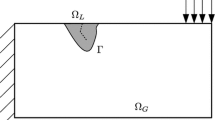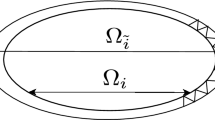Abstract
This paper presents a study on efficient and economical domain decomposition adaptivity for Richards equation problems. Many real world applications of the Richards equation model typically involve solving systems of linear equations of huge dimensions. Multi-thread methods are therefore often preferred in order to reduce the required computation time. Multi-thread (parallel) execution is typically achieved by domain decomposition methods. In the case of non-homogeneous materials, the problem conditioning can be significantly improved if the computational domain is split efficiently, as each subdomain can cover only a certain material set within some defined parameter range. For linear problems, e.g. heat conduction, it is very easy to split the domain in this way. A problem arises for the nonlinear Richards equation, where the values of the constitutive functions, even over a homogeneous material, can vary within several orders of magnitude, see e.g. Kuraz et al. (Appl Math Comput 2012, in press). If the Rothe method is considered for time integration, a robust algorithm will be obtained if the domain is split adaptively over the time integration levels. The domain decomposition technique considered here is the standard multiplicative Schwarz method with coarse level, see e.g. Toselli and Widlund (Domain decomposition: methods algorithms and theory, Springer, Berlin, 2005). A method of the domain decomposition adaptivity will be studied in this paper.





Similar content being viewed by others
References
Kuraz M, Mayer P, Havlicek V, Pech P, Pavlasek J (2012) Dual permeability variably saturated flow and contaminant transport modeling of a nuclear waste repository with capillary barrier protection. Appl Math Comput (in Press)
Toselli A, Widlund O (2005) Domain decomposition: methods algorithms and theory. Springer, Berlin
Richards LA (1931) Capillary conduction of liquids through porous media. Physics I 1:318–333
Neuman SP, Witherspoon PA (1970) Finite element method analyzing steady seepage with a free surface. Water Resour Res 6:889–897
Alt HW, Luckhaus S (1983) Quasilinear elliptic-parabolic differential equations. Math Z 183:311–341
Celia MA, Bouloutas ET, Zarba RL (1990) A general mass-conservative numerical solution for the unsaturated flow equation. Water Resour Res 26:1483–1496
Kačur J (2001) Solution of nonlinear and degenerate convection-diffusion problems. Nonlinear Anal 47:123–134
Šolín P, Kuráž M (2011) Solving the nonstationary Richards equation with adaptive hp-FEM. Adv Water Resour 34:1062–1081
Kees CE, Farthing MW, Dawson CN (2008) Locally conservative, stabilized finite element methods for variably saturated flow. Comput Methods Appl Mech Eng 197(51):4610–4625
Kuráž M, Mayer P, Lepš M, Trpkošová D (2010) An adaptive time discretization of the classical and the dual porosity model of Richards’ equation. J Comput Appl Math 233:3167–3177
Tocci MD, Kelley CT, Miller CT (1997) Accurate and economical solution of the pressure head form of the Richards equation by the method of lines. Adv Water Resour 20:1–14
Dryja M, Widlund OB (1990) Towards a unified theory of domain decomposition algorithms for elliptic problems. SIAM, Philadelphia, pp 3–21
Schwarz HA (1870) Über einen Grenzbergang durch alternierendes Verfahren. Vierteljahrsschrift der Naturforschenden Gesellschaft in Zürich 15:272–286
Schwarz HA (1890) Uber eine grenzubergang durch alternirendes ver-fahren. Gesammelete Mathematische Abhandlungen 2:133–143
Benzi M, Frommer A, Nabben R, Szyld DB (2001) Algebraic theory of multiplicative Schwarz methods. Numer Math 89:605–639
Dryja M, Widlund OB (1987) An additive variant of the Schwarz alternating method for the case of many subregions. Ultracomputer Note, 131
Cai XC (1990) Additive Schwarz algorithms for parabolic convection-diffusion equations. Numer Math 60:41–62
Cai XC (1994) Multiplicative Schwarz methods for parabolic problems. SIAM J Sci Comput 15:587–603
Blaheta R, Kohut R, Neytcheva M, Stary J (2007) Schwarz methods for discrete elliptic and parabolic problems with an application to nuclear waste repository modelling. Math Comput Simul 76:18–27
Jenkins EW, Kees CE, Kelley CT, Miller CT (2006) An aggregation-based domain decomposition preconditioner for groundwater flow. SIAM J Sci Comput 23:420–441
Herbst M, Gottschalk S, Reißel M, Hardelauf H, Kasteel R, Javaux M, Vanderborgh J, Vereecken H (2008) On preconditioning for a parallel solution of the Richards equation. Comput Geosci 34:1958–1963
Cooley RL (1983) Some new procedures for numerical solution of variably saturated flow problems. Water Resour Res 19:1271–1285
Paniconi C, Aldama AA, Wood EF (1991) Numerical evaluation of iterative and noniterative methods for the solution of the nonlinear Richards equation. Water Resour Res 27:1147–1163
Miller CT, Williams GA, Kelley CT, Tocci MD (1998) Robust solution of Richards’ equation for nonuniform porous media. Water Resour Res 34:2599–2610
Phoon KK, Tan TS, Chong PC (2007) Numerical simulation of Richards equation in partially saturated porous media: under-relaxation and mass balance. Geotech Geol Eng 25:525–541
Nabben R (2003) Comparisons between multiplicative and additive Schwarz iterations in domain decomposition methods. Numer Math 95:145–162
van Genuchten MTH (1980) A closed-form equation for predicting the hydraulic conductivity of unsaturated soils. J Soil Sci 44:892–898
Mualem Y (1976) A new model for predicting the hydraulic conductivity of unsaturated porous media. Water Resour Res 12:513–522
Kuraz M, Mayer P (2012) Algorithms for solving Darcian flow in structured porous media. In: Proceedings of Acta Polytecnica
Kuraz M (2012) DRUtES: open source FEM library for coupled convection-difussion-reaction problems. http://www.freecode.com/projects/drutes
Noborio K, McInnes KJ, Heilman JL (1996) Two-dimensional model for water, heat, and solute transport in furrow-irrigated soil: I. Theory Soil Sci Soc Am J 60:1001–1009
Acknowledgments
Financial support from the Technology Agency of the Czech Republic (research project TA02021249) is gratefully acknowledged.
Author information
Authors and Affiliations
Corresponding author
Rights and permissions
About this article
Cite this article
Kuraz, M., Mayer, P., Havlicek, V. et al. Domain decomposition adaptivity for the Richards equation model. Computing 95 (Suppl 1), 501–519 (2013). https://doi.org/10.1007/s00607-012-0279-8
Received:
Accepted:
Published:
Issue Date:
DOI: https://doi.org/10.1007/s00607-012-0279-8
Keywords
- Poor conditioning
- Slow convergence of the Picard method
- Highly heterogeneous material properties
- Multiplicative Schwarz method
- Diagonal scaling




